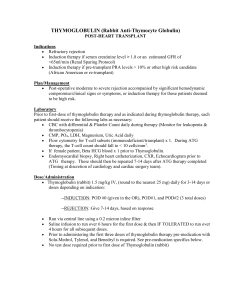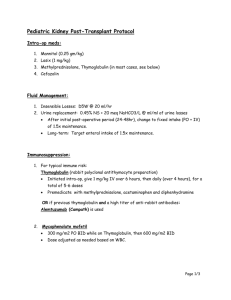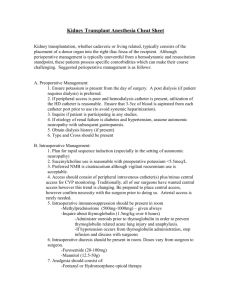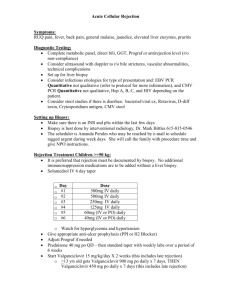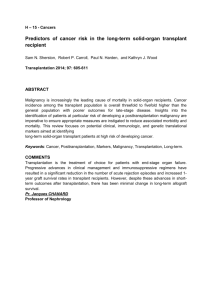Induction immunosuppression in kidney transplantation:
advertisement
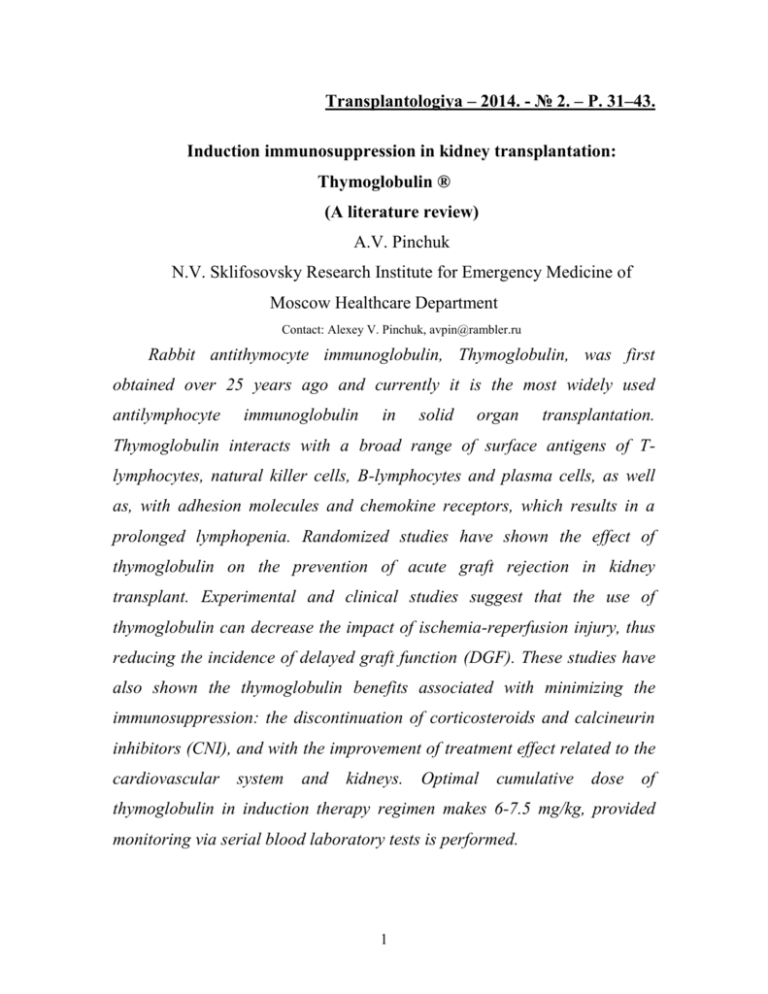
Transplantologiya – 2014. - № 2. – P. 31–43. Induction immunosuppression in kidney transplantation: Thymoglobulin ® (A literature review) A.V. Pinchuk N.V. Sklifosovsky Research Institute for Emergency Medicine of Moscow Healthcare Department Contact: Alexey V. Pinchuk, avpin@rambler.ru Rabbit antithymocyte immunoglobulin, Thymoglobulin, was first obtained over 25 years ago and currently it is the most widely used antilymphocyte immunoglobulin in solid organ transplantation. Thymoglobulin interacts with a broad range of surface antigens of Tlymphocytes, natural killer cells, B-lymphocytes and plasma cells, as well as, with adhesion molecules and chemokine receptors, which results in a prolonged lymphopenia. Randomized studies have shown the effect of thymoglobulin on the prevention of acute graft rejection in kidney transplant. Experimental and clinical studies suggest that the use of thymoglobulin can decrease the impact of ischemia-reperfusion injury, thus reducing the incidence of delayed graft function (DGF). These studies have also shown the thymoglobulin benefits associated with minimizing the immunosuppression: the discontinuation of corticosteroids and calcineurin inhibitors (CNI), and with the improvement of treatment effect related to the cardiovascular system and kidneys. Optimal cumulative dose of thymoglobulin in induction therapy regimen makes 6-7.5 mg/kg, provided monitoring via serial blood laboratory tests is performed. 1 Currently, the induction with thymoglobulin is indicated for patients at high immunological risk (an increased DGF risk), and also for maintenance of immunosuppression effect in the kidney recipients at low risk who receive treatment with low doses of steroids and calcineurin inhibitors (CNIs), or in case of their complete withdrawal. Keywords: thymoglobulin, immunosuppression, renal transplantation. Clinical potential of antilymphocyte preparations as indicated for the prevention of acute graft rejection in solid organ transplantation was recognized more than 40 years ago [1]. A number of various agents have been developed on the basis of antilymphocyte globulin (ALG) and antithymocyte globulin (ATG) derived from different animal species. The equine ALG was the first agent used in a clinical practice for a kidney transplant in 1966 by Starzl and his colleagues [2]. No early acute rejection occurred and, meanwhile, the ALG also appeared effective in the prevention of a chronic graft rejection [3]. Further years of intense research led to the development of thymoglobulin, a rabbit ATG, that demonstrated a high efficacy in suppressing the immune cell response in experimental animal studies. Being first tested in a clinical setting in the early 1970s, thymoglobulin became available in France in 1984, and later, in other countries around the world. In Europe and the United States, thymoglobulin has remained the most widely used ATG preparation. Currently, thymoglobulin is well known to reduce significantly the incidence of acute rejection after renal transplantation [1]. This is achieved by using an effective immunosuppression in the early posttransplant period which ensures a reliable protection of renal transplant in patients both at low 2 and high immunological risk [4]. However, despite a large experience with thymoglobulin in kidney transplantation, many aspects of its use need further clinical studies. In clinical practice, there is no consensus regarding the optimal dose, treatment duration or categories of transplant recipients in whom thymoglobulin may be the most effective agent. This review article presents the data from literature relating the basics of contemporary knowledge on induction therapy using thymoglobulin in renal transplant recipients, including such issues as the mechanism of drug action, its use for the prevention of acute rejection, and its potential effect on delayed graft function (DGF), as well as immunosuppression minimization protocols using low doses of steroids and calcineurin inhibitors (CNIs), the review of the drug safety profile, the practical issues of thymoglobulin use, and the clinical and laboratory monitoring of a recipient. Mechanism of action Unlike monoclonal antibodies, the polyclonal antithymocyte antibodies, such as thymoglobulin, act on a wide range of T-lymphocyte surface antigens, and also contain antibodies to natural killer cell antigens, Blymphocyte antigens, plasma cell antigens, adhesion molecules, and chemokine receptors [5] (Figure). 3 Thymoglobulin immunosuppressive activity is primarily a result of the T-lymphocyte depletion. This leads to a rapid and profound reduction in the number of CD3+ T-lymphocytes in blood. However, despite widelyconducted research [6], the exact mechanisms of this dose-dependent lymphopenia have not been adequately studied yet. Thymoglobulin concentration (> 100 mcg/ml) that is necessary to trigger the classical complement cascade activation and the lymphocyte lysis in vitro, could hardly be achieved in vivo [6]. On the contrary, Thymoglobulin®-induced apoptosis of activated T cells via Fas/FasL-dependent [7] and the Fas/FasLindependent [8] cascade occurs even with its low concentration (1 mcg/ml). T-cell depletion may also be induced by antibody-dependent cellular cytotoxicity (ADCC) because the rabbit IgG can bind to human Fcreceptors, which results in ADCC of activated lymphocytes in vitro, even at low concentrations (1-10 mcg/ml). Furthermore, it is assumed that the 4 treatment using thymoglobulin results in the T-cell immunological tolerance and the suppression of T-cell functional molecular activity [9]. The treatment of cynomolgus monkeys using thymoglobulin has proved to induce a dose-dependent lymphopenia in blood and, to a lesser extent, in the spleen and lymph nodes, but not in thymus [6]. The same study demonstrated a significant T-lymphocytopenia when using a low dose of the drug (equivalent to 0.15-0.20 mg/kg/day in humans) that is less than the dose currently used in clinical transplantation. Meanwhile, the dose that is commonly used in clinical practice (0.8-1.0 mg/kg/day) induces an even more severe lymphopenia. A very high dose (equivalent to 3.5 mg/kg/day) results in almost complete T-cell depletion in the lymph nodes and the spleen [6]. This data suggests that the lymphopenia level in peripheral tissues may be dependent on a peak thymoglobulin concentration, rather than on its total dose. In addition to its lymphocyte-depleting property, thymoglobulin has been proven to cause T lymphocyte functional changes that were evidenced by the impaired proliferative response in the monkeys' lymph node cells, and by the negative modulation of T-cell surface molecules [6]. Taken together, multiple thymoglobulin effects on immune system, namely, a profound lymphopenia, tolerance and activation of tolerogenic cells, were the subjects of interest in a number of clinical trial protocols. Primarily, thymoglobulin was investigated for its efficacy in the prevention of graft rejection, for its pharmacokinetic properties, and for thymoglobulininduced lymphopenia effects, meanwhile, a probable thymoglobulinstimulated functional tolerance may be an objective for further investigations. 5 Prevention of acute rejection Acute rejection continues to have its negative impact on graft survival. So the suppression of lymphocyte function is crucial in the first posttransplantation week. In the period from 1967 to 1976 (before the advent of cyclosporine), an early use of polyclonal ALG agents when ALG was administered for the first 2 weeks after renal transplantation resulted in improved patient survival rates and graft function, although it was accompanied by the increased incidence of sepsis [10, 11]. ATG preparations have shown a greater efficacy and have been associated with a better tolerance than monoclonal antilymphocyte antibodies OKT-3 [12]. In a randomized double-blind trial, Hardinger K.L. et al. [13] compared thymoglobulin versus ATGAM (equine ATG) for the induction therapy in kidney transplant patients receiving CNI-based immunosuppression and found that thymoglobulin was associated with higher than ATGAM event-free survival (94% vs. 63%), lower acute rejection rates (4% vs. 25%) and better graft survival in the first 5 years after kidney transplantation, its comparative values being retained through 10 years [14]. Since the mid-1990s, interleukin-2 receptor antagonists (IL-2RA) have become the agents of choice for induction therapy after kidney transplantation. A meta-analysis of 71 studies comparing the induction with IL-2RA with no induction demonstrated a relative risk of acute rejection at one year making 0.67 (95% CI: 0.59-0.76) [15]. Acute rejection, patient and graft survival rates in patients at low immunological risk [4, 16, 17] appear similar with the induction using either IL-2RA or thymoglobulin, regardless of the maintenance therapy regimen, but with better tolerance in case of IL6 2RA induction [15, 18]. Two large randomized trials compared thymoglobulin versus IL-2RA induction in KTx patients at high immunological risk [4]. In this setting, induction using thymoglobulin appeared superior over IL-2RA induction with regard to prevention of acute rejection, in general, and of steroid-resistant acute rejection, in particular, but thymoglobulin induction resulted in a greater number of bacterial infections [4]. A reduced acute rejection rate at 1 year after transplantation was sustained throughout a period of next 5 years with similar rates of patient and graft survival [19]. Interesting is the stratified analysis in one of these randomized studies that gave reason to believe that the advantage of thymoglobulin induction, when compared to IL-2RA, in reducing acute rejection cases may be referred rather to renal transplant recipients from standard criteria donors (SCDs) than for recipients of renal transplant from extended criteria donors (ECDs) [20]. Comparative efficacy of the induction with thymoglobulin versus IL2RA was also investigated by Organ Procurement and Transplantation Network (OPTN) in a retrospective analysis of data from a registry of 19,137 recipients who received a kidney transplant during 2001-2005 [21]. The patients received either the thymoglobulin induction, basiliximab induction, or the maintenance regimen only with tacrolimus and mycophenolate mofetil (MMF), with or without steroids. When assessing the efficacy as a composite endpoint of acute allograft rejection, graft loss, and death, the relative risk reduction by 22% was observed with thymoglobulin induction compared to that of basiliximab (0.78, 95% CI: 0.69 - 0.87), and compared to no induction (0.64, 95% CI: 0.58-0.71) in patients who received steroids; with even a more pronounced risk reduction compared to that resulted from basiliximab use in the patients not receiving steroids at 7 hospital discharge, though the statistical significance was borderline (0.66, 95% CI: 0.44-1.00). Thymoglobulin and delayed graft function Ischemia and microcirculatory disturbance caused by ischemiareperfusion injury (IRI) inevitably occur in solid organ transplantation. Leukocytes have been considered responsible for many pathophysiologic changes during IRI, including the activation of leukocyte adhesive molecules that leads to the reperfused tissue infiltration and apoptosis, and to the mediation of cytotoxic effects, as well [22]. In addition to leukocytes, Tlymphocytes have recently been identified as important cellular mediators in IRI [23]. Thymoglobulin may contribute to IRI prevention by suppressing the activation and adhesion of inflammatory cells and mediators, as well as due to the development of leukopenia and lymphopenia. ATG preparations have been shown to modify leukocyte surface antigens and block adhesion molecules, reducing the degree of posttransplant leukocyte adhering along capillary endothelial surfaces [22], diminishing leukocyte infiltration [24], inhibiting proinflammatory mediators involved in the mechanisms of endothelial cell destruction [5], and limiting reperfused tissue apoptosis [25]. Thymoglobulin acts on a number of leukocyte targets and endothelial cell markers [26]. In a clinical trial, W.C. Goggins et al. [27] reported that intraoperative administration of thymoglobulin prior to reperfusion reduced significantly the incidence of DGF compared to its postoperative administration (3.5% vs. 14.8%, p<0.05), and also improved the kidney function at 10 and 14 days after transplantation, meanwhile, the length of hospital stay reduced. Thymoglobulin induction in patients at risk of developing DGF can be an effective method allowing a delayed initiation of 8 CNI therapy in order to increase the chance of graft function recovery in the early posttransplant period. In case of IL-2RA induction, no advantage has been achieved regarding the incidence of acute rejection or DGF compared to immediate CNI introduction [28]. Withdrawal or avoidance of corticosteroids Long-term corticosteroid therapy is associated with a number of side effects which include skin lesions, osteoporosis, hypertension, diabetes, dyslipidemia; therefore the optimal strategy is to minimize the dose of corticosteroids. Given its efficacy in the prophylaxis of acute cellular rejection, and in the prevention long-term immunological effects, thymoglobulin was investigated for use to facilitate an early steroid withdrawal. In a large double-blind, randomized study, the incidence of acute rejection was evaluated in 500 patients treated with triple therapy using cyclosporine, MMF and conventional regimen of corticosteroids or half-dose steroids for 3 months with their subsequent withdrawal [29]. Only 34% of recipients received thymoglobulin or OKT-3, and on the 6th month of the study, the incidence of biopsy-proved acute rejection was significantly higher in the low dose/early glucocorticosteroid termination group (23% compared to 14% in the conventional corticosteroid treatment group, p=0.008), the difference being retained throughout 12 months (25% vs. 15%) in the entire study population. However, in the subgroups of patients who received thymoglobulin induction, the incidence of acute rejection was similar regardless of the corticosteroid therapy (13.4% in the low dose/early therapy termination group vs. 11.5% in the conventional corticosteroid treatment group, p=N/A) [29]. These data, for the first time, gave grounds to suggest 9 the possibility of minimizing steroid administration without increasing acute rejection rates, provided the patients had received induction therapy with thymoglobulin. Complications such as cytomegalovirus (CMV) infection, cataract, newly diagnosed diabetes, and aseptic necrosis were significantly less likely to occur in patients receiving treatment without corticosteroids that raised interest in such a treatment strategy [29]. In another randomized study of 151 living-donor renal transplant recipients, an early corticosteroid withdrawal on the 8-th day with using a thymoglobulin induction was associated with the same acute rejection rate that was observed with conventional corticosteroid treatment, but without induction (13.9% versus 19.4%, not significant) [30]. Taken together, these results suggest that the use of thymoglobulin in corticosteroid-minimizing protocols, specifically those of early withdrawal within the first week after kidney transplantation, can improve clinical outcomes without increasing the incidence of acute rejection. Withdrawal or avoidance of calcineurin inhibitors The use of calcineurin inhibitor agents in clinical transplant practice have reduced the acute rejection rates and has resulted in improving the short-term renal allograft survival, but has had little effect on its long-term survival because of adverse events such as nephrotoxicity, malignancies, and cardiovascular risks. After preliminary studies where a thymoglobulin induction demonstrated good results in the framework of CNI dosereduction protocols, specifically in the patients who received kidney transplants from marginal donors [31, 32], the thymoglobulin induction was used in three prospective controlled randomized studies to accelerate a 10 complete CNI termination in recipients who received sirolimus. In the study of M. Buchler et al., 150 de novo renal allograft recipients were randomized to receive either sirolimus without CNI or a standard regimen with cyclosporine. The patients of both groups were administered MMF and corticosteroids [33]. All patients received thymoglobulin for 5 days. At 12 months after transplantation, the patient and graft survival rates were similar in both groups (97% vs. 97%, and 90% vs. 93%, for sirolimus and cyclosporine groups, respectively). Corticosteroid withdrawal was planned at 6 months posttransplantation and was actually achieved in more than 80% of patients in each of two groups. The incidence of biopsy-proven rejection was low and similar in two groups (14.3% in sirolimus group vs. 8.6% in cyclosporine group, p=0.30). The same was seen in relation to the symptom severity. At 12 months, the kidney graft function, as assessed by the estimated glomerular filtration rate (eGFR) (calculated using Nankivell’s formula) did not differ between the groups throughout the whole study population. However, among patients who continued to receive the treatment, eGFR at 12 months was significantly higher (68.7 ± 19 ml/min vs. 60.1 ± 13.8 ml/min) with a difference of 8 ml/min being noted as early as at 2 months after transplantation [33]. At 5 years post-transplantation, the positive trend retained, and indeed, it became more pronounced (a mean eGFR was 63.8±21.9 ml/min in sirolimus group vs. 46.6±18.2 ml/min in cyclosporine group, p<0.01). Meanwhile, there was no statistical differences between the two groups in relation to the late acute rejection rate (two patients with biopsy-confirmed acute rejection in the sirolimus group, vs. six in the cyclosporine group, p=0.28) or in relation to the appearance of antiHLA-antibodies [34]. Seventy-seven percent of patients who received 11 sirolimus, and 72% of those randomized to cyclosporine did not take corticosteroids for subsequent 5 years. In a more recent study including 141 patients with kidney allograft, D. Glotz et al. [35] compared the efficacy and safety of CNI-free regimen with sirolimus versus tacrolimus therapy. All patients in the sirolimus group received thymoglobulin induction during the first 5 days following transplantation, whereas in the tacrolimus group, thymoglobulin could be given in case of DGF only. At 1-year follow-up, the incidence of biopsyproven acute rejection was similar in the two groups, but the proportion of graft loss was significantly higher in the sirolimus group compared to that of tacrolimus. However, in patients with functioning grafts, the renal function was significantly better in the sirolimus group throughout 9 months [35]. Contrary to these data obtained when using thymoglobulin induction, two large randomized studies of CNS-free treatment regimens with the use of IL-2RA induction (SYMPHONY [36] and ORION [37]) have shown disappointing results. In all cases, the incidence of biopsy-confirmed acute rejection was significantly higher in the CNI-free regimen group (37.2% and 31.3% at 1 year in SYMPHONY and ORION studies, respectively). That made the ORION study sponsor to discontinue the study for the patients of CNI-free regimen group. This disagreement between the studies in assessing the efficacy of CNIfree regimens in combination with the use of mTOR-inhibitors and thymoglobulin or IL-2RA induction suggests that it is the thymoglobulin immunosuppressive activity rather than that of IL-2RA agents gives sufficient grounds to refrain from administering CNI in the initial posttransplantation weeks when the risk of rejection is the highest. 12 Thymoglobulin administration Prevention of acute rejection. What is the optimal dose? The data obtained in the studies on non-human primates where thymoglobulin was administered in a dose range of 1-20 mg/kg demonstrated that both peripheral blood lymphopenia, and the T-cell depletion in the spleen and lymph nodes were dose-dependent [6]. However, despite a long history of thymoglobulin usage to prevent rejection after kidney transplantation, the optimal dosing regimen in this setting has not yet been defined. This is reflected in the manufacturer's summary of product characteristics for the clinical use where the recommended dose makes 1-1.5 mg/kg/day for 2-9 days after transplantation [38] resulting in a cumulative dose being equal to 2-13.5 mg/kg. The cumulative dose was decreased over time and currently it is established at approximately 6-7.5 mg/kg. In clinical studies of efficacy and safety, excellent results were obtained with the cumulative dose being 67.5 mg/kg [7, 39, 40]. A recent retrospective review of 188 kidney transplants has proved that early acute rejection occurs more frequently with the thymoglobulin cumulative dose of lower than 6 mg/kg [41]. Conversely, using high doses (1.5 mg/kg/day for 9 days, i.e. the cumulative dose of 13.5 mg/kg) was associated with a high incidence of infectious diseases, particularly CMV-infection. A three-day administration regimen has been noted to be as safe and effective as a 7-day one, with the decreased number of primary hospitalizations, but that was based on a non-randomized study with historical control groups. What is the optimal duration of therapy? Duration of thymoglobulin administration varies between centers using therapy courses of different length: from less than 4 days, to 4--7-day courses or longer; but in general, the therapy duration was decreased over time and currently makes 3-5 days, 13 as a rule [42]. When should thymoglobulin administration be started? To minimize the risk of DGF, the first thymoglobulin dose could be administered during surgery [37]. The evidence that such an approach provides a DGF risk reduction in the patients receiving thymoglobulin is still controversial, so that postoperative administration is also acceptable (see "Thymoglobulin and delayed graft function"). To reduce the risk of acute reactions induced by thymoglobulin, its administration is recommended as intravenous infusion via the high flux vein (central vein or arterio-venous shunt) for at least 6 hours for the first infusion, and for at least 4 hours for subsequent dosing. This is considered a standard approach for induction therapy. Special situations Treatment of acute rejection. Thymoglobulin is often considered as an agent for the treatment of a severe or steroid-resistant rejection. The dose recommended for the acute rejection therapy of 1.5 mg/kg/day for 7-14 days should be infused intravenously using a vein in the high flux for at least 6 hours for the first infusion, and for at least 4 hours on the following days of treatment. Thymoglobulin and kidney transplant in pediatrics. As an induction therapy in children, a thymoglobulin dose of 1.5-2.5 mg/kg once a day for 510 days was used [43-46]. A relatively short (5-day) course at a dose of 1.5 mg/kg/day may be equal by its efficacy to a longer regimen [45], but the data are limited. Monitoring and safety. If a standard dosing regimen and therapy duration are not sustained, any short-term and long-term thymoglobulin effects on hematology and immune system should be monitored. 14 Measurement of the lymphopenia level in the short term allows a daily dose adjustment. T-cell depletion may be assessed either by monitoring the white blood cell (WBC) count, or by a flow cytometric analysis of T-lymphocyte subpopulations. The most widely used test is CD3+ T-cell count performed daily or 3 times per week. It is aimed at keeping the lymphocyte count at less than 200/mm3 and/or CD3+ T-cell count at less than 20/mm3. In terms of thymoglobulin administration, this level of lymphopenia is considered consistent with the absence of acute cellular rejection. Possible causes of failure to achieve an adequate lymphopenia include retransplantation or the presence of anti-thymoglobulin antibodies. In case of excessive lymphopenia, a thymoglobulin dose adjustment is required. The dose should be reduced by a half if the WBC count has decreased to 2000-3000/mm3 with possible early termination of thymoglobulin therapy in cases when WBC count falls below 2000/mm3, as indicated in the summary of product characteristics for clinical use. Thymoglobulin is well tolerated, causes neither anaphylaxis, nor local reactions at application site [40]. Nevertheless, infusion reactions such as fever or rash, leukopenia and thrombocytopenia observed in 25% of patients should not affect making decisions on the thymoglobulin dose and therapy duration. The most frequently reported adverse event, a moderate fever due to cytokine release, might occur during the first 3 days of administration. Respiratory symptoms that may be caused by the cytokine release are relatively rare (2.5%) [40]. Thymoglobulin effects on hematology, such as thrombopenia (<50x109/L), occur with a similar frequency, and usually do not require the drug discontinuation. However, the dose reduction by a half is recommended if the platelet count drops to 50 000-75 000/mm3, and the drug administration should be stopped at a value below 50 000/mm3. 15 Serum sickness with or without fever and arthralgia, rash and lymphadenopathy was reported arising at 7-11 days after transplantation in 7.5% of cases in the 1990s. [40]. But currently it occurs less frequently (in 0.25%) owing to a lower total/cumulative dose and shorter therapy duration [47]. Serum sickness is more common in patients who were previously treated with thymoglobulin, and even more common in patients with previous history of serum sickness. Its symptoms are usually relieved by using high doses of corticosteroids [47]. The association between antithymocyte therapies and CMV infection is well established. The thymoglobulin treatment has been reported to be associated with increased incidence and severity of CMV infection and pneumocystis pneumonia, especially in patients who has never received a prophylaxis therapy [48]. One small prospective study [49] suggested a possible relationship between thymoglobulin exposure and BK-poliomavirus infection. This may be especially true in patients receiving high-dose thymoglobulin (> 500 mg), so it is recommended to check for the BKpoliomavirus infection for at least 6 months after transplantation [50]. The effects of high-dose thymoglobulin are not unexpected, since higher levels of immunosuppression have been accepted as a major risk for BK virus replication and nephropathy [49]. Pneumocystis pneumonia has also been noted in patients receiving thymoglobulin induction [48]. CD4+ T-cell lymphopenia (<300/mm3) persisting for 3 post-transplantation months may require a prolonged antiviral and anti-pneumocystic (Pneumocystis carinii) prophylaxis, as well as the adjustment of the maintenance immunosuppressive therapy regimen. Nevertheless, the above data give the grounds to say that an adequate prophylaxis of infectious complications can significantly minimize the risk of their occurrence. 16 The impact of the CD4+ T-cell lymphopenia on the risk of malignancies remains controversial, that is associated with the increase in the incidence of some types [51], but not all, [52] malignant neoplasms. No prospective studies of posttransplant lymphoproliferative diseases in renal transplant patients receiving thymoglobulin, has been conducted yet. D. Tribaudin et al. [53] reported that in a sequential analysis of CD4+ and CD8+ lymphocyte subsets for a 10-year period, an early detected low number of CD4+ cells had a less significant predictive value for the occurrence of cancer compared to the age and duration of graft survival. Conclusion: The literature data suggest that, thanks to its unique mechanism of action, efficacy and good safety profile, thymoglobulin has been and still remains the most important drug in the arsenal of immunosuppressive agents. Based on the data of experimental and clinical studies conducted for the past decade, the thymoglobulin use can be considered from the point of the benefits to be obtained in specific situations. First, there is substantial evidence proving that thymoglobulin may be the agent of choice for KTx recipients at high immunological risk (e.g., in cases of sensitization and/or re-transplantations), as well as for patients receiving a transplant with a high risk of DGF from expanded criteria donors. Recently, a kidney transplantation from an asystolic donor has been considered a cause of IRI in recipients leading to a high incidence of DGF (approximately 50%, rising up to 80% in some cases). In these conditions, the thymoglobulin-induced lymphopenia in transplantation might reduce the tissue damage. Second, it can be affirmed that the thymoglobulin induction 17 may be required to minimize a routine posttransplant use of steroids and CNIs. Compared to the use of IL-2RA inhibitors, the induction with lymphocyte-depleting agents effectively reduces the risk of acute rejection associated with the immunosuppressive minimization which has been convincingly confirmed by a number of studies. Minimization of steroid or CNI administration is highly desirable in specific situations (e.g., in elderly recipients, organ transplantation from expanded criteria donors), and with thymoglobulin use it is possible to provide the expected benefits without reducing the degree of immunological safety. References 1. Gaber A.O., Monaco A.P., Russell J.A., et al. Rabbit antithymocyte globulin (thymoglobulin): 25 years and new frontiers in solid organ transplantation and haematology. Drugs. 2010; 70 (6): 691–732. 2. Starzl T.E. Heterologous antilymphocyte globulin. N. Engl. J. Med. 1968; 279 (13): 700–703. 3. Starzl T.E., Porter K.A., Iwasaki Y., Marchioro T.L., Kashiwagi N. The use of heterologous antilymphocyte globulin in human renal homotransplantation. In: Wolstenholme GEW, O’Connor MJ, editors. Antilymphocytic Serum. London: J. & A. Churchill, Ltd; 1967. 4–34. 4. Brennan D.C., Daller J.A., Lake K.D., et al. Thymoglobin Induction Study Group. Rabbit antithymocyte globulin versus basilix-imab in renal transplantation. N. Engl. J. Med. 2006; 355 (19): 1967–1977. 5. Bonnefoy-Berard N., Vincent C., Revillard J.P. Antibodies against functional leukocyte surface molecules in polyclonal antilym-phocyte and antithymocyte globulins. Transplantation. 1991; 51 (3): 669–673. 18 6. Preville X., Flacher M., LeMauff B., et al. Mechanisms involved in antithymocyte globulin immunosuppressive activity in a nonhuman primate model. Transplantation. 2001; 71 (3): 460–468. 7. Genestier L., Fournel S., Flacher M., et al. Induction of Fas (Apo-1, CD95)-mediated apoptosis of activated lymphocytes by polyclonal antithymocyte globulins. Blood. 1998; 91 (7): 2360–2368. 8. Michallet M.C., Saltel F., Preville X., et al. Cathepsin-B-dependent apoptosis triggered by antithymocyte globulins: a novel mechanism of T-cell depletion. Blood. 2003;102 (10): 3719–3726. 9. Merion R.M., Howell T., Bromberg J.S. Partial T-cell activation and anergy induction by polyclonal antithymocyte globulin. Transplantation. 1998; 65 (11): 1481–1489. 10. Diethelm A.G., Aldrete J.S., Shaw J.F., et al. Clinical evaluation of equine antithymocyte globulin in recipients of renal allograft: analysis of survival, renal function, rejection, histocompatibility, and complications. Ann. Surg. 1974; 180 (1): 20–28. 11. Najarian J.S., Simmons R.L., Condie R.M., et al. Seven years’ experience with antilymphoblast globulin for renal transplanta-tion from cadaver donors. Ann. Surg. 1976; 184 (3): 352–368. 12. Uslu A., Nart A. Treatment of first acute rejection episode: systematic review of level I evidence. Transplant. Proc. 2011; 43 (3): 841– 846. 13. Hardinger K.L., Schnitzler M.A., Miller B., et al. Fiveyear follow up of thymoglobulin versus ATGAM induction in adult renal transplantation. Transplantation. 2004; 78 (1): 136–141. 14. Hardinger K.L., Rhee S., Buchanan P., et al. A prospective, randomized, double-blinded comparison of thymoglobulin versus Atgam for 19 induction immunosuppressive therapy: 10-year results. Transplantation. 2008; 86 (7): 947–952. 15. Webster A.C., Playford E.G., Higgins G., et al. Interleukin 2 receptor antagonists for kidney transplant recipients. Cochrane Database Syst Rev. 2010; (1): CD003897. 16. Ciancio G, Burke G.W., Gaynor J.J., et al. A randomized trial of three renal transplant induction antibodies: early comparison of tacrolimus, mycophenolate mofetil, and steroid dosing, and newer immune-monitoring. Transplantation. 2005; 80 (4): 457-465. 17. Abou-Ayache R., Buchler M., Lepogamp P., et al. CMV infections after two doses of daclizumab versus thymoglobulin in renal transplant patients receiving mycophenolate mofetil, steroids and delayed cyclosporine A. Nephrol. Dial. Transplant. 2008; 23 (6): 2024–2032. 18. Vincenti F., de Andres A., Becker T., et al. Interleukin-2 receptor antagonist induction in modern immunosuppression regimens for renal transplant recipients. Transplant Int. 2006; 19 (6): 446–457. 19. Brennan D.C., Schnitzler M.A. Long-term results of rabbit antithymocyte globulin and basiliximab induction. N. Engl. J. Med. 2008; 359 (16): 1736–1738. 20. Hardinger K.L., Brennan D.C., Schnitzler M.A. Rabbit antithymocyte globulin is more beneficial in standard kidney than in extended donor recipients. Transplantation. 2009; 87 (9): 1372–1376. 21. Willoughby L.M., Schnitzler M.A., Brennan D.C., et al. Early outcomes of thymoglobulin and basiliximab induction in kidney transplantation: application of statistical approaches to reduce bias in observational comparisons. Transplantation. 2009; 87 (10): 1520–1529. 20 22. Mehrabi A., Mood Z.A., Sadeghi M., et al. Thymoglobulin and ischemia reperfusion injury in kidney and liver transplantation. Nephrol. Dial. Transplant. 2007; 22 Suppl. 8: viii54-viii60. 23. Huang Y., Rabb H., Womer K.L. Ischemia-reperfusion and immediate T-cell responses. Cell. Immunol. 2007; 248 (1): 4–11. 24. Beiras-Fernandez A., Chappell D., Hammer C., Thein E. Influence of polyclonal antithymocyte globulins upon ischemia–reper-fusion injury in a non-human primate model. Transplant. Immunol. 2006; 15 (4): 273–279. 25. Beiras-Fernandez A., Thein E., Chappell D., et al. Polyclonal antithymocyte globulins influence apoptosis in reperfused tissues after ischemia in a non-human primate model. Transplant. Int. 2004; 17 (8): 453–457. 26. Mueller T.F. Mechanisms of action of Thymoglobulin. Transplantation. 2007; 84 Suppl. 11: 5–10. 27. Goggins W.C., Pascual M.A., Powelson J.A., et al. A prospective, randomized, clinical Thymoglobulin in trial adult of intraoperative cadaveric renal versus transplant postoperative recipients. Transplantation. 2003; 76 (5): 798–802. 28. Kamar N, Garrigue V, Karras A., et al. Impact of early or delayed cyclosporine on delayed graft function in renal transplant recipients: a randomized, multicenter study. Am. J. Transplant. 2006; 6 (5 Pt. 1): 1042– 1048. 29. Lebranchu Y., Aubert P., Bayle F., et al. Could steroids be withdrawn in renal transplant patients sequentially treated with ATG, cyclosporine, and cellcept? One-year results of a double-blind, randomized, multicenter study comparing normal dose versus low-dose and withdrawal of steroids. M 55002 French. Study Group. Transplant. Proc. 2000; 32 (2): 396–397. 21 30. Woodle E.S., Peddi V.R., Tomlanovich S., et al. Study Investigators. A prospective, randomized, multicenter study evaluating early corticosteroid withdrawal with Thymoglobulin in living-donor kidney transplantation. Clin. Transplant. 2010; 24 (1): 73–83. 31. Swanson S.J., Hale D.A., Mannon R.B., et al. Kidney transplantation with rabbit antithymocyte globulin induction and sirolimus monotherapy. Lancet. 2002; 360 (9346): 1662–1664. 32. Grinyo J.M., Gil-Vernet S., Cruzado J.M., et al. Calcineurin inhibitor-free immunosuppression based on antithymocyte globu-lin and mycophenolate mofetil in cadaveric kidney transplantation: results after 5 years. Transplant. Int. 2003; 16 (11): 820–827. 33. Buchler M., Caillard S., Barbier S., et al. Sirolimus versus cyclosporine in kidney recipients receiving thymoglobulin, mycophe-nolate mofetil and a 6-month course of steroids. Am. J. Transplant. 2007; 7 (11): 2522–2531. 34. Lebranchu Y., Snanoudj R., Toupance O., et al. Five-year results of a randomized trial comparing de novo sirolimus and cyclo-sporine in renal transplantation: the Spiesser study. Am. J. Transplant. 2012; 12 (7): 1801– 1810. 35. Glotz D., Charpentier B., Abramovicz D., et al. Thymoglobulin induction and sirolimus versus tacrolimus in kidney transplant recipients receiving mycophenolate mofetil and steroids. Transplant. 2010; 89 (12): 1511–1517. 36. Ekberg H., Tedesco-Silva H., Demirbas A., et al. Reduced exposure to calcineurin inhibitors in renal transplantation. N. Engl. J. Med. 2007; 357 (25): 2562–2575. 22 37. Flechner S.M., Glyda M., Cockfield S., et al. The ORION Study: comparison of two sirolimus-based regimens versus tacrolimus and mycophenolate mofetil in renal allograft recipients. Am. J. Transplant. 2011; 11 (8): 1633–1644. 38. Thymoglobulin 25 mg powder for solution for infusion: summary of product characteristics. Available at: http://www.medi-cines.org.uk/emc/medicine/20799/SPC. 39. Brennan D.C., Flavin K., Lowell J.A., et al. A randomized, doubleblinded comparison of Thymoglobulin versus Atgam for induction immunosuppressive therapy in adult renal transplant recipients. Transplantation. 1999; 67 (7): 1011–1018. 40. Buchler M., Hurault de Ligny B., Madec C., et al. Induction therapy by anti-thymocyte globulin (rabbit) in renal transplanta-tion: a 1-yr followup of safety and efficacy. Clin. Transplant. 2003; 17 (6): 539–545. 41. Tsapepas D., Mohan S., Crew R.J., et al. Small thymoglobulin dose adjustments have profound impact on early rejections in renal transplantation. Am. J. Transplant. 2011; 11 Suppl. 2: 147 42. Hardinger K.L. Rabbit antithymocyte globulin induction therapy in adult renal transplantation. Pharmacotherapy. 2006; 26 (12): 1771–1783. 43. Khositseth S., Matas A., Cook M.E., et al. Thymoglobulin versus ATGAM induction therapy in pediatric kidney transplant recipients: a single-center report. Transplantation. 2005; 79 (8): 958–963. 44. Schwartz J.J., Ishitani M.B., Weckwerth J., et al. Decreased incidence of acute rejection in adolescent kidney transplant recipi-ents using antithymocyte induction and triple immunosuppression. Transplantation. 2007; 84 (6): 715–721. 23 45. Brophy P.D., Thomas S.E., Mcbryde K.D., Bunchman T.E. Comparison of polyclonal induction agents in pediatric renal trans-plantation. Pediatr. Transplant. 2001; 5 (3): 174–178 46. Kamel M.H., Mohan P., Little D.M., et al. Rabbit antithymocyte globulin as induction immunotherapy for pediatric deceased donor kidney transplantation. J. Urol. 2005; 174 (2): 703–707. 47. Boothpur R., Hardinger K.L., Skelton R.M., et al. Serum sickness after treatment with rabbit antithymocyte globulin in kidney transplant recipients with previous rabbit exposure. Am. J. Kidney Dis. 2010; 55 (1): 141–143. 48. Issa N., Fishman J.A. Infectious complications of antilymphocyte therapies in solid organ transplantation. Clin. Infect. Dis. 2009; 48 (6): 772– 786. 49. Dadhania D., Snopkowski C., Ding R., et al. Epidemiology of BK virus in renal allograft recipients: independent risk factors for BK virus replication. Transplantation. 2008; 86 (4): 521–528. 50. Srinivas T.R., Schold J., Guerra G., et al. Total rabbit ATG dose is a risk factor for onset of BK viremia in kidney transplant recipients. Am. J. Transplant. 2007; 7 Suppl. 2: 235. 51. Ducloux D., Carron P.L., Motte G., et al. Lymphocyte subsets and assessment of cancer risk in renal transplant recipients. Transplant. Int. 2002; 15 (8): 393–396. 52. Glowacki F., Al Morabiti M., Lionet A., et al. Long-term kinetics of a T-lymphocytes subset in kidney transplant recipients: relationship with posttransplant malignancies. Transplant. Proc. 2009; 41 (8): 3323–3325. 53. Thibaudin D., Alamartine E., Mariat C., et al. Long-term kinetic of T-lymphocyte subsets in kidney-transplant recipients: influence of anti-T24 cell antibo-dies and association with Transplantation. 2005; 80 (10): 1514–1517. 25 posttransplant malignancies.
